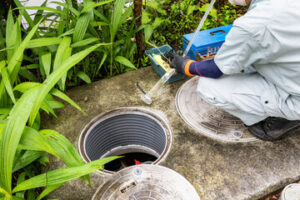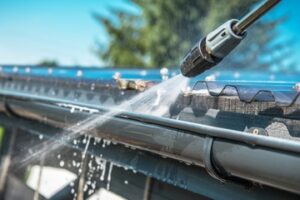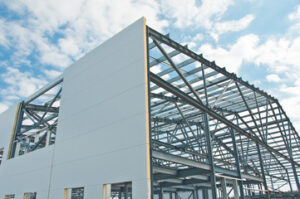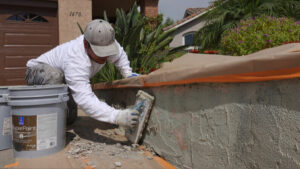Septic systems have to endure a lot: chemical cleaners, toxic drain openers, excessive soap and paper, and more. Knowing what to look out for can help keep your septic tank and drain field in tip-top shape.
Click Here to learn more about the common types of septic systems.

Clogged Drains
A well-maintained septic system quietly manages wastewater while keeping your home healthy and safe. But like any major home system — such as the air conditioner or electric wiring — neglecting your septic system can lead to problems that require professional help. Issues such as a slow-draining toilet, sewage backups, and suspicious wet spots in the yard are red flags that indicate it’s time to call in the experts.
Septic tank clogs are a common and often unavoidable problem, but there are ways to minimize them. For starters, always avoid flushing anything that doesn’t belong in the toilet, such as toys, paper towels, and feminine hygiene products. In addition, try to limit water usage in your home and use a garbage disposal sparingly.
Regular septic tank pumping and keeping accurate maintenance records will also help prevent clogs. While many homeowners turn to over-the-counter drain cleaners when a septic tank is clogged, these chemical solutions are harmful to the bacteria in the septic tank and can cause further damage to the plumbing of the home.
Another common sign that it’s time to call in a septic expert is when the septic tank fills up more quickly than it should. This can occur if the tank is undersized for household usage or if the microbial process can’t keep up with demand. Installing a larger tank or taking steps to reduce water usage in the home can remedy this.
Leaking septic tanks can be caused by several things, including corrosion that happens over time, poor installation, and tree roots getting into the system. The best way to identify a leaking septic tank is to have a septic professional come out and perform an inspection. This will include examining the tank and looking at all of the pipes, especially those that connect to the drainfield.
In some cases, a septic tank can be repaired or relined to fix the leak, but in other instances, the system may need to be completely replaced. A septic expert will be able to determine the cause of the leaking and offer recommendations that will restore proper functioning.
Overflowing Tanks
Many people think of their septic system as a vital part of the home but one that is out of sight and out of mind until something goes wrong. If your septic tank is full, you need to take immediate action. A septic system will only be able to absorb a certain amount of wastewater each day, and if it receives more than that regularly, the system will overflow. This is because the natural bacteria inside a septic tank that helps break down solids and waste won’t be able to keep up.
A septic tank that is leaking or overflowing is not just an unsightly mess but also a health hazard. The sewage and waste that are leaking from your tank can get into the soil surrounding it, where it can cause illness in children, pets, and adults. The odors created by the sewage and waste can also be very unpleasant, and these smells may even make their way into your house.
Your septic tank will only be able to hold a certain number of gallons, and if you are using more water than that daily, your septic system will fill up too fast and overflow. This is especially true if your household has increased in size or you are experiencing holiday or vacation water usage.
Another sign of a full or overflowing septic tank is standing water around the drain field area. Heavy rainfall or rainstorms that last for several days can cause the ground around your septic system to become saturated, which prevents wastewater from being absorbed by the absorption field. A septic professional should be called to examine the situation and determine the cause of the problem so that it can be fixed.
Keeping up with the routine maintenance schedule for your septic system will help ensure that it functions well and that problems don’t arise. Everyday care is needed, too, which means thinking twice about what you are flushing down your toilets. This includes avoiding the use of chemical drain cleaners and other products that are not safe for your septic system. Also, make sure that you keep trees and other deep-rooted plants at least 30 feet away from your septic tank. They can cause damage to the pipes that carry the wastewater from your home.
Leaking Pipes
Many urban homes connect to municipal sewer systems, but rural and country areas still use septic systems for waste management. An up-to-date septic system with proper maintenance can function effectively for decades before any talk of replacement becomes necessary, but if your system gets neglected, it will likely need immediate attention to avoid costly and hazardous consequences.
An Overflowing Absorption Field
When wastewater leaves your house, it travels through a drain pipe into the septic tank. Here, solids sink while liquids float, and microorganisms break down some of the contaminants. The septic tank also has a distribution box that sends partially treated wastewater to the drain field.
The septic tank needs to be pumped regularly to avoid overflowing. If you notice the water in your septic system flowing more slowly than usual, it may indicate that the tank is filling faster than normal. This could be caused by an increase in water usage or the tank being undersized for your household. It is important to have your septic system professionally inspected and, if needed, resized.
You should also pay special attention to what goes down the drains and toilets in your home. Your septic system is not designed to handle items like tampons, disposable diapers, sanitary products, paper towels, and plastics. These substances can create blockages, cause clogs, and even contaminate the environment.
The area over your septic tank and absorption field should be kept clear of any plants other than mowed grass. Plant roots can damage your tank and clog drain lines. In addition, invasive plants such as ivy can quickly choke out and destroy the roots of your septic tank.
Leaking pipes are another indication that your septic system is not working properly. This could be a result of corrosion from old age, poor installation, or tree roots. The best way to fix this problem is to have your septic tank pumped and have the leaking line between the septic tank and absorption field checked by a professional. A septic expert can repair or replace the damaged line with no further leaks.
Foul Odors
When a toilet flushes or sink drains, it sends sewage into the septic tank. A watertight, underground container designed to hold a maximum of 1,000 gallons, the tank receives the waste and holds it for 24 hours while allowing microorganisms to break down organic materials. The resulting liquid is then carried into the absorption field. Unless the tank is cleaned, waste gases may escape into the house, leading to foul odors.
A septic system requires regular cleaning, monitoring, and pumping. A failure to perform any of these tasks can lead to clogs, sewage backups, and the need for a complete system replacement. However, if you know the early warning signs, you can prevent system failure and avoid costly repairs.
Foul odors in the home are often the first sign of a septic system problem. These odors are caused by a buildup of gases that are too acidic for the septic system to digest. The smell of sewage entering the home often indicates that there is a leak in the septic tank or leach field pipes. This can be the result of corrosion from a corrosive cleaner, poor installation, or plant roots growing into septic system components.
The best way to prevent odors is to keep solid materials out of the septic system. Grease, food scraps, diapers, sanitary products, and facial tissue should be disposed of in the trash instead of flushed down the drains. This will help maintain proper septic tank levels and reduce the amount of solid material that is carried into the absorption field.
There are septic system additives available that promote bacteria growth to break down solids. However, research has found that these chemicals disrupt the natural bacterial activity in the tank and cause damage to pipes and tanks. Hydrogen peroxide, on the other hand, is effective in breaking down septic tank solids and maintaining a healthy septic system. For the best results, use septic-safe enzyme additives every week. This will help ensure that a minimum of solids is left in the tank and help to speed up organic decomposition in the septic tank and leach field.








